| Economy of Istalia | |
|---|---|
 Terran Global Financial Center in Romula | |
| Rank | Top-3 (on 58) |
| Currency | £ Istalian Lira (LIS) |
| Trade organisations |
Majatran Alliance and Common Economic Area Terran Association of Free Trade International Majatran Trade Agreement World Financial Trade Center |
| Statistics | |
| GDP |
£ 619,251,643,874 (4199) |
| GDP per capita |
£ 6,214 LIS (4199) |
| Labour force | 102,126,475 |
| Labour force by occupation | Services, industry, agriculture |
| Unemployment | 6.8% |
| Main industries | Oil, natural gas, high-tech technology, financial services, intense machinery, automotive, aerospace, consumers goods |
| External | |
| Export goods | Oil, natural gas, petrochemicals, processed rare-earth elements, financial services, high-tech technology, telecommunications, arms, food products |
| Main export partners | Solentia, Selucia, Dorvik, Zardugal, Kalopia-Wantuni, Hutori, Luthori |
| Import goods | Mineral raw materials, chemicals, consumer goods, semifinished products, wood, several fornitures |
| Main import partners | Baltusia, Malivia, Indrala, Cildania, Mordusia, Third Word Nations |
| Public finances | |
| Revenues | £ 130,117,449,176 |
| Expenses | £ 128,750,000,000 |
| Credit rating | AAA |
The Istalian Economy is a modern market economy and currently is one of the three major economy worldwide and the most developed in Majatra, came back to be the economic powerhouse it was since 42th century after having recovered from the crisis which interested the country between 49th and 50th centuries, after that the authorities under the two Unions of Quanzar and Alaria and currently under the Third Empire worked to climbe the cope aimed to come back to the status Istalia had previously. It relies mainly on the tertiary sector, turism and on advanced services and worldwide trade, then on heavy industry focused on advanced and state-of-art technology, but very developed are also the small and middle-size family-run manufactures and agricultural sectors which produces high quality luxury goods and agri-wine products. Istalia has economic relationships worldwide, with many of the most powerful nations but also with several emerging economies and exports primary services and high-tech products, cars as well as agri-wine, luxury and fashion products, for which Istalia is renowned worldwide, and also entertainment productions like movies and tv series. This large and highly advanced economy assures to the Istalians one of highest standard of living on Terra.
Its internal GDP is divided as below:
- Primary sector: 3,9%
- Secondary sector: 31,2%
- Tertiary sector: 64,9%
History[]
Early periods of contemporary era[]
For many centuries, at least under the Emirate of Quanzar, the economy of the istalian lands was based on the agri-food activities, mostly localized in Trivendito, in north Padagna and in Sarregna, exporting massively in the other eastern Majatran countries, benefing of the decisively more favorable condition of the climate and the environment compared with the neighboring countries.
With the establishment of the Union of Quanzari Soviets and the collectivisation of most part of economy, started an industrialization process which led to the establishment of a robust heavy industry and the expansion of other activities of the primary sector like the mining with the begining of the exploitation of the large salt reserves of the central desertic plains, but also of the reserve of silver, iron, zinc, gypsum, feldspar and potassium.
With the foundation of the First Istalian Republic the old collectivized system was quickly abandonend in favor of the market economy, however, the State continued to be present in the economy which evolved into a mixed economy with several state-owned companies in the key sector.
Istalian economy during the millenia more or less mainteined its charateristic, thanks to the stability of the four successive Republic (while the Quanzarian restored regimes never adopted widespread changes on the economic structure and system continuing to support a market economy).
The landing of foreign companies into the stalian economy in the fourth millennia contributed to developed the istalian know how into secondary sector, for example thanks to the establishment of several industrial sites, like the one of the Kostandian Bay Maritime Corporation, a Zardic shipbuilt company. However, the competion with the foreign companies caused serious problems for the internal industry which for some time relied excessively on the foreign presence. In 37th century istalian companies beginning to grow and to take more space in the istalian economy and it's in this period that have been founded notable companies like Enist and Leonardi.
Reaching the hights of global economy[]
At the end of 41st century, after the tragedy of the Civil War, thanks to a new more international oriented policy, the Istalian economy became its growth which in less than a century make Istalia rose among the major economies worldwide. 42nd century saw the expansion of giant multinational corporations outside the istalian markets and the growth interested particularly the third sector with holding, banks and assurance companies which expanded their activities landing and massively investing in foreign markets. At the end of the following century the istalian economy had become fully globalized housing large multinational conglomerates.
An enormous opportunity for the istalian economy under the Fourth Republic was the massive penetration of companies and multinationals in Kalopia-Wantuni, a land without centralized government since the end of the 41st century, dominated by anarcho-capitalism and which saw istalian companies extend a quasi-governative control on many areas of the majatranan central nation, especially across the entire Mossavi region.
In the following centuries Istalian firms and investments were presents in most of the nations of world and during the years of the Majatran Alliance Istalian economy had so weight into the whole Majatra economy that once the Black Thursday hit the country in the middle of 45th century the whole Majatran economy was engulfed into a prolonged crisis which forced most of the Majatran countries to adopt extraordinary measures to cope the crisis. Istalia didn't fully recovered from this crisis indeed, also because the decline of the Majatran Alliance and the failure of the ephemeral Union of the Majatran Nations were all factors that hit furthermore the Istalian economy.
The Istalian Empire[]
While Istalia was recovering from the 45th century crisis, the Istalian War against the Thallerist Revolution hit the country which economy plunged to levels never seen since the first years of the the New Fourth Republic. The Fifth Republic, however, represented a veritable renascence for the Istalian economy which growth continued quickly under the First Istalian Empire. The First Imperial Era saw the Istalian economy fully recovering came back to be one of the most developed worldwide, evolving furthermore with the oil and gas sector which activity decreased domestically while increasing abroad and high-tech technologies taking more space into the istalian industrial sectors. Generally, however, the Istalian economy was a little less internationally oriented compared to the times under the New Fourth Republic. Under the Empire Istalia focused a lot on attracting evermore turists and develop this sector which had always represented one of the most important resources of the country thanks to its millennia-old history and artistic heritage. Technology and research too became sector so much important for Istalia that for the celerbations of the 200th anniversary of the foundation of the Empire the technology was the theme of a great international expo organized for the occasion. Istalian space technology reached too its peak and several Istalian companies had hegemonized the space private market worldwide.
The economic crisis unleased in Deltaria in the middle of 49th century hit seriously Istalia which economy entered a period of decline also because Istalian politics was not able to contrast the crisis as fasten as before due to internal political clashes between the political forces which preceeded the abolition of the Empire and the establishment of the Six Republic.
Decline[]
The Six Republic was a period of decline for Istalian economy which didn't never recovered from the crisis which hit Istalia under the last decades of the First Empire and the internal stagnant political situation didn't help. Most of the large multinational corporation retired from international markets and many began a progressive decline which led to their future definitive decline.
Resurgence[]
Under the Union of Quanzar and Alaria, the Istalian Union of Quanzar and Alaria and finally under the current Third Empire, political forces have worked to make recover the Istalian economy from the crisis and since the first decades of the Third Empire Istalian economy has come back to be the most developed in Majatra and among the most developed worldwide, focused on state-of-art and precision manufacturing and IT technology, tourism, third sector services, export of luxury and food-wine products, and still on some very important heavy industrial activities like shipbuilding and oil and gas sector although mainly oriented in refinering, hydrocarbons chemical industry and export of services.
Primary sector[]
Agriculture, breeding and fishing[]
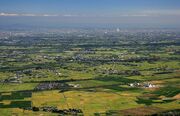
Cultivated Plain
Despite the agri-food sector in the third millennia starts to decrease its importance in the istalian economy, still today it maintains an important role for the istalian economy and it is foundamentally divided in intensive industrial agriculture and in smaller production of excellences. The lush plains on the Peninsula and on the Island are intensively exploited and produces all the typical cultivation of the Majatran area also if during the centuries spread also foreign cultivations like the rice, produced especially in Ferano along the shores of the river Risodor. Of the total surface area in agricultural use, grain fields take up 31%, olive tree orchards 9.2%, vineyards 7.4%, citrus orchards 5.8%, sugar beets 4.4%, and horticulture 4.7%. The remainder is primarily dedicated to pastures (25.9%) and feed grains (11.6%).

Hills in Trivendito cultivated with vineyards
The breeding is diffused mostly on the highlands of Ferano and Trivendito, in Fidelia and in Cisavugli. Livestock includes 8 million head of cattle, 9.6 million head of swine, 7 million head of sheep, and 1.1 million head of goats. The total annual production of the fishing industry from capture and aquaculture, including crustaceans and molluscs, stood at 1040 tons. This high ammount of fish is due to the massive exploitation of the Perartic Ocean by part of the fishing industry with the Istalian fishing vessels which reach also the waters close to the antartic circle.
Mineral resources[]
The mining sector formerly had a major role in the Istalian economy, with activities in the north of Fidelia and south of Ferano, in the central desertic area of the nation where there are many salt, gypsum, feldspat and potassium mines, while silver, zinc and iron mines could be found in the north padagna and in Silicia (the biggest silver mines of Istalia was localized here).
The sector today, however, has greatly reduced its role, focusing by now on the extraction of feldspat and potassium, about which is a world's leading producers, while for most part of the row material it depends from the import, focusing then on the processing and manufacturing of these materials.
Energy resources[]
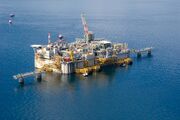
One of the largest Enist's platform in the Perartic Ocean
The oil and gas sector was heavily really expoloied between 41th and 48th centuries and assumed a very crucial role for the Istalian economy. The extraction, refination and distribution of oil, and its derivates, and natural gas became probably the most important secondary industry in Istalia.
The first discovered and exploited oil fields were located in the north of the Sarrentina Peninsula, between Trivendito and Ferano, at the foot of the northern mountain ranges, but the veritable heart of the oil industry of Istalia was located miles away south of Istalia, into the open Perartic Ocean, from which Istalia extracted also huge ammounts of natural gas.
The crude oil from the extraction sites for the refination reachs instead the several facilities on the Peninsula, the main of them located in Taranda, Argintera and first of all in Villaneddìa, where there is the largest one refinery and stock piles facilities of Istalia.

"Petrochemical city" of Villaneddìa
Thanks to the intensive activities of the fields in the Perartic Ocean, not exploited by other countries, or at least not at all at the same level, Istalia, despite a costantly expanding internal demand, was able to export huge amounts of oil, oil derivates and, especially since the end of the 42th century, natural gas, making Istalia one of the major oil products exporting countries on Terra.
Istalia energetic sector, however, doesn't relies exclusively on the oil and natural gas, but Istalia has also high technologic knowledge in the nuclear energy as well as on the renewable ones. The national energy demands is satisfied mainly through gas and nuclear plants, but since the ban of fuel oil and coal as energetic resources for the electric production (first half of 42nd century), the renewable technologies greatly increased their presence.
Since 48th century Istalian inland oil and gas reserves had been fully exploited and with the economic crisis oil and gas sector became to decline and never recovered as in previous time. Under the Union of Quanzr and Alaria, however, the newlyfounded company Gasper began once again the extraction of natural gas from the Perartic Ocena.
Secondary sector[]
Heavy and High-tech Industry[]
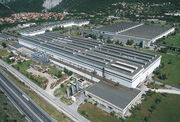
Industrial facilities in Padagna
The secondary sector in Istalia is dominated by the heavy industry oriented on numerous productions, from the durable and consumer goods to the intense machinery, automotive, aerospace and naval Induatry. It is developed also the sector of the transformation of Raw Materials on which markets Istalia is a major producers and exporters of all oil derivatives and is a world's leading producers of processed rare-earth elements. Since 51th century superconductors industry assumed a preminent role.

Aeronautic engine
A major role has also the high-tech industry which produces electronic products, home appliance manufactures, informatic software and hardware, mobile phone and other high-tech products, leader of which is the company Oliverdi S.p.A.. Into the heavy industry, the leader corporations is the multinational giants Leonardi Industrial Group, followed by companies like Estal or Ajace Aeronautics.
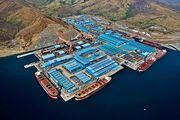
Leonardi's yards in Triesta
Often forgotten, but more for political reasons, despite its importance, it is also the arms industry, on which market Istalia is a world's leading country, which produces any kind of armaments from the sidearms and the recognition drones to the armoured vehicles, fighter aircrafts and large war vessels. A well known firm of the sector is OTO Al-Mehara Armamenti. Leader of the processed food, instead, is Farilla, largely active also abroad, especially in the third world, where it owns thousands of squadre kilometers of cultivate terrains.
Manufacturing sector[]

Some products of the istalian luxury manufacturing
Along side the larger corporations, in Istalia is also developed a deep-seated manufacturing sector consisting of small or medium-size enterprises, often family-owned, of low technology but high craftsmanship, specialized in clothing, leather products, footwear, furniture, textiles, machine tools, spare parts, appliances, and jewellery. This has produced a manufacturing sector often focused on the export of niche market and luxury products, that on one side is less capable of competing on quantity, but on the other side is more capable of facing the competition from emerging economies based on lower labor costs, with higher quality products.
Terziary sector[]
Services and Financial[]

Romula International Stock Exchange
Since the end of the 41st century the tertiary in Istalia experienced the most rapid growth with many investment groups, holdings, banks and other financial companies expanding their services in Istalia as well as abroad.
In the first half of the 42nd century arose one of the most important company of this sector, the Umana Servizi S.p.A, a 'Global Multi-utility' that offers also financial, assurance and private social services, controlled by the biggest istalian holding, Hasan Grand Holding S.p.A., today one of the larger holding corporations worldwide, detaining important shareholdings or controlling many national companies, especially in the financial sector, and also numerous foreign industrial and financial groups and companies.
The most important national Stock Exchanges is the Milona Stock Exchange (Istalian: Borsa di Milona), making the capital of Padagna the financial center of Istalia. However, since Istalia became one of the major economy worldwide and the most important financial center of Majatra, arose in prominance and importance the Romula International Stock Exchange, located in the well known Terran Global Financial Center.
Since the second half of 44th century two institution established by the Government contributed to the further development of the istalian economic system and financial importance: the Deposits and Consignments Fund and the Istalian Strategic Investment Fund. The former was established as veritable state investment bank to loan money to the State as well as to the local governments but, probably most important, to support the most strategic industries as well as new businesses and start up and cultural and scientific institutions. To persue its goals the Fund use as first resource the postal savings of the Istalian National Postal Service. The Strategic Fund, instead, was established by the Government to be a Sovereign wealth fund, in the form of an investment company aimed to invest the Government's budgetary surplus and the foreign exchange reserves of the Bank of Istalia to, as specified in the establishing law, save for the future, to strengthen the economy, and to improve the quality of life of Istalians. The Strategic Fund persues its goals investing in profitable projects that generate income and in the long term. The Strategic Fund is authorized to create and manage a portfolio composed of real and financial assets such as stocks, bonds, real estate, precious metals, private equity fund or hedge funds. The Strategic Fund is aimed to invest in the most important global companies, with special interest for the Majatran markets, so to become one of the most important economic actor of the world.
Telecommunications, Broadcasting and Entertainment[]
Istalian houses large telecommunication and entertainment industries, higly advanced, charaterized by a deep integration between the traditional entertainment devices and the web potentialities. The companies of this sector have a veritable calling for the international markets, offering products of quality like international tv series and web content. Major entertainment corporation in this sector is the TerraMedia, giant broadcasting, entertainment and news conglomerate, present in all the nations of Terra, heavily diffused particularly in Artania, and the largest broadcasting network on Majatra.
About the telecommunication industry, Istalia present one of the most developed internet networks as well as many providers of phone and internet services and among them the largest corporations also in the phone services industry is without dubt Istelecom, which is a major actor also in many foreign countries, especially in Majatra.
International Trade[]
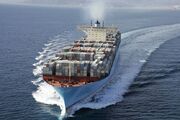
Supercontainer ship of Hasan Aeductus
Istalia can boast one of the largest civil fleet of Terra, consisting of thousands of vessels from the smaller fishing vessels to the enormous tankers and containers ships of Hasan Aeductus World Shipping, one of the main controlled corporations of Hasan-Mariani, established at the end of the 42nd century when Hasan World Shipping merges with the Selucian Aeductus Inter Shipping to create what is today one of the larger shipping company of the world.
Furthermore the extension of the Port of Triesta in the first decades of the 43rd century, as part of the measures to support the economy facing the greatest economic crisis of history, allowed to Istalia to host the largest port hub of the eastern Majatra and so to become the veritable eastern continental door, if not the main one of Majatra.
Transport[]
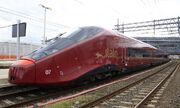
Istalian high speed train
Istalia has very extensive networks of highways and motorways, either on the Peninsula and on the Island, which collegue effectively the main cities as well as the countryside. The only large area in Istalia where there isn't roads, a part dirt-tracks, is the Pheykran Basin, due to the presence of the almost unhabitated homonymous desert. But Istalia can boast also an higly developed high speed rail network operated by several private companies. The Istalian transport networks is higly integrated into the Majatran one, due to the fact that at the end of the 41st century Istalia was the promoter of the Trans-Majatran Corridors Network, a continental project which increased drammatically the trade and the voyages across Majatra.
Developed are also the railways and especially the high-speed networks connecting fastly the major cities. The railways industries currently is totally managed by private TOCs, national as well as regional, but the market is dominated by few large comapnies, among them NTI - Nuovo Trasporto Istaliano and Alaria Trasporti Integrati. Both of them offer international connections, not only from and to Istalia, but also in other countries, having profited also the competitors in this market of the railways integration promoted by the mentioned Trans-Majatran Networks.
Istalia houses also important airlines like IstalAir and MajAir, the former the unofficial flagship airline of Istalia (it is not a state company) which connect the country worldwide and the latter a recently created low-cost branch dedicated specifically to the low and medium range transport across Majatra.
Tourism[]
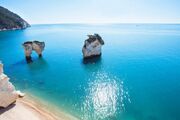
A beach in Alaria
Very important is also the touristic sector, being able to offer to visitors from around the world natural beauty like the temperate rainforests of the south, the beautiful beaches of Alaria, heavily heated in summer also by the hot current from the north as well as the eastern coasts of the Peninsula.
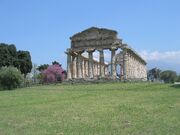
Selucian colonization's ruins
Istalia can also boast a huge cultural offer with many archaeological sites like Qolshamih, Tuffad or the many remains of the ancient selucian colonies, then the historical cities rich of the testimonials of the age-old history of the country where the tourists can also enjoy a lot of museums and artistic spaces of any kind.
